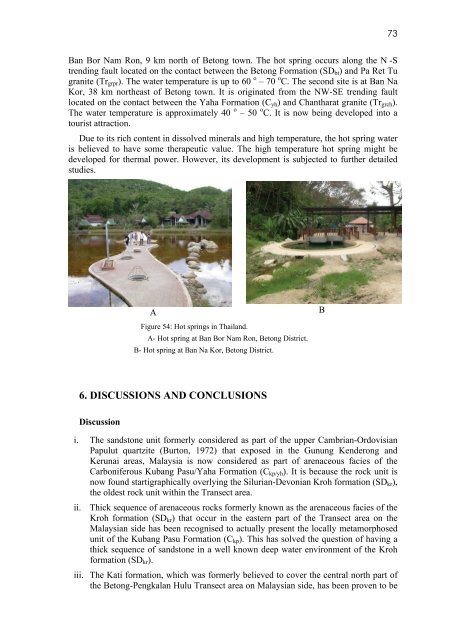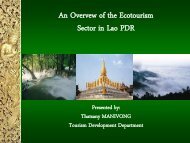GEOLOGY OF THE PENGKALAN HULU-BETONG TRANSECT ...
GEOLOGY OF THE PENGKALAN HULU-BETONG TRANSECT ...
GEOLOGY OF THE PENGKALAN HULU-BETONG TRANSECT ...
Create successful ePaper yourself
Turn your PDF publications into a flip-book with our unique Google optimized e-Paper software.
Ban Bor Nam Ron, 9 km north of Betong town. The hot spring occurs along the N -S<br />
trending fault located on the contact between the Betong Formation (SDbt) and Pa Ret Tu<br />
granite (Trgrpr). The water temperature is up to 60 o – 70 o C. The second site is at Ban Na<br />
Kor, 38 km northeast of Betong town. It is originated from the NW-SE trending fault<br />
located on the contact between the Yaha Formation (Cyh) and Chantharat granite (Trgrch).<br />
The water temperature is approximately 40 o – 50 o C. It is now being developed into a<br />
tourist attraction.<br />
Due to its rich content in dissolved minerals and high temperature, the hot spring water<br />
is believed to have some therapeutic value. The high temperature hot spring might be<br />
developed for thermal power. However, its development is subjected to further detailed<br />
studies.<br />
A<br />
Figure 54: Hot springs in Thailand.<br />
A- Hot spring at Ban Bor Nam Ron, Betong District.<br />
B- Hot spring at Ban Na Kor, Betong District.<br />
6. DISCUSSIONS AND CONCLUSIONS<br />
Discussion<br />
i. The sandstone unit formerly considered as part of the upper Cambrian-Ordovisian<br />
Papulut quartzite (Burton, 1972) that exposed in the Gunung Kenderong and<br />
Kerunai areas, Malaysia is now considered as part of arenaceous facies of the<br />
Carboniferous Kubang Pasu/Yaha Formation (Ckp/yh). It is because the rock unit is<br />
now found startigraphically overlying the Silurian-Devonian Kroh formation (SDkr),<br />
the oldest rock unit within the Transect area.<br />
ii. Thick sequence of arenaceous rocks formerly known as the arenaceous facies of the<br />
Kroh formation (SDkr) that occur in the eastern part of the Transect area on the<br />
Malaysian side has been recognised to actually present the locally metamorphosed<br />
unit of the Kubang Pasu Formation (Ckp). This has solved the question of having a<br />
thick sequence of sandstone in a well known deep water environment of the Kroh<br />
formation (SDkr).<br />
iii. The Kati formation, which was formerly believed to cover the central north part of<br />
the Betong-Pengkalan Hulu Transect area on Malaysian side, has been proven to be<br />
B<br />
73



